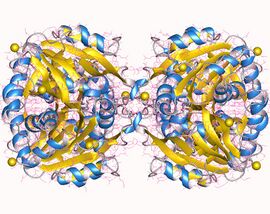Biology:2-alkenal reductase
From HandWiki
Short description: Class of enzymes
| 2-alkenal reductase | |||||||||
|---|---|---|---|---|---|---|---|---|---|
 Leukotriene B4 12-hydroxydehydrogenase (NADP-dependent) dimer, Human | |||||||||
| Identifiers | |||||||||
| EC number | 1.3.1.74 | ||||||||
| CAS number | 9032-20-6 | ||||||||
| Databases | |||||||||
| IntEnz | IntEnz view | ||||||||
| BRENDA | BRENDA entry | ||||||||
| ExPASy | NiceZyme view | ||||||||
| KEGG | KEGG entry | ||||||||
| MetaCyc | metabolic pathway | ||||||||
| PRIAM | profile | ||||||||
| PDB structures | RCSB PDB PDBe PDBsum | ||||||||
| Gene Ontology | AmiGO / QuickGO | ||||||||
| |||||||||
In enzymology, a 2-alkenal reductase (EC 1.3.1.74) is an enzyme that catalyzes the chemical reaction
- n-alkanal + NAD(P)+ alk-2-enal + NAD(P)H + H+
The 3 substrates of this enzyme are n-alkanal, NAD+, and NADP+, whereas its 4 products are alk-2-enal, NADH, NADPH, and H+.
This enzyme belongs to the family of oxidoreductases, specifically those acting on the CH-CH group of donor with NAD+ or NADP+ as acceptor. The systematic name of this enzyme class is n-alkanal:NAD(P)+ 2-oxidoreductase. Other names in common use include NAD(P)H-dependent alkenal/one oxidoreductase, and NADPH:2-alkenal alpha,beta-hydrogenase.
Structural studies
As of late 2007, three structures have been solved for this class of enzymes, with PDB accession codes 2DM6, 2J3J, and 2J3K.
References
- "The NADPH:quinone oxidoreductase P1-zeta-crystallin in Arabidopsis catalyzes the alpha,beta-hydrogenation of 2-alkenals: detoxication of the lipid peroxide-derived reactive aldehydes". Plant Cell Physiol. 43 (12): 1445–55. 2002. doi:10.1093/pcp/pcf187. PMID 12514241.
- "Antioxidative function and substrate specificity of NAD(P)H-dependent alkenal/one oxidoreductase. A new role for leukotriene B4 12-hydroxydehydrogenase/15-oxoprostaglandin 13-reductase". J. Biol. Chem. 276 (44): 40803–10. 2001. doi:10.1074/jbc.M105487200. PMID 11524419.
 |
